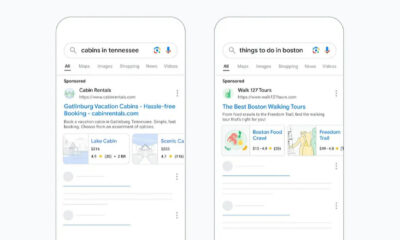SEO
14 Types Of Google Ads Extensions & What They Do

If Google Ads are a part of your marketing strategy, you’re probably always on the lookout for ways to boost performance.
You not only want more clicks, but you want more high-quality clicks, from the type of user who takes action once they hit your landing page.
But that’s easier said than done. You could spend countless hours tweaking every ad as you A/B test minute differences in copy and structure – or you could utilize Google Ads extensions.
You may be familiar with Google Ads extensions; you may have read about them or maybe you’re even using them already.
But you may not realize Google adds more types nearly every year.
This guide will help you understand each type of ad extension, so you can optimize them for maximum performance and get more bang for your PPC buck.
Google Ads Extensions Basics
Let’s start at the beginning.
What Are Google Ads Extensions?
You may already have guessed the answer to this one: Google Ads extensions extend your ads, claiming more real estate on search engine results pages (SERPs) and helping searchers make decisions.
Why Should You Use Them?
There are two main benefits to ad extensions that are so ubiquitous, nearly every advertiser can benefit from them:
1. They allow you to provide more information: Larger ad text lets you make a stronger case to targets about why they should click on your ad.
2. They increase your visibility on SERPs: The larger size of extended ads makes them more impactful.
Through these two factors alone, ad extensions can increase your clickthrough rate (CTR) significantly – possibly several percentage points. And this isn’t even considering their other benefits, which include:
- Improved lead quality: By providing more information, extended ads allow poor-quality leads to self-disqualify, so you get fewer irrelevant clicks. The people who click through to your landing page are far more likely to take the desired action.
- Better ad ranking: Google uses a variety of factors to determine your ad position, including expected CTR, relevance, and landing page experience. Simply using ad extensions will automatically improve your ranking, because it allows Google to offer a better variety of ad formats.
- Better use of your PPC budget: Because they improve your CTR, ad extensions can help lower your cost-per-click (CPC), which in turn means you’re getting more out of your paid ad spend.
Manual And Automated Extensions
There are two general extensions categories: manual, which requires some setup, and automated.
Most of the extensions discussed here are manual, though some of them can also be dynamically applied by Google when it predicts they will improve performance.
It’s important to note that in February 2022, Google announced several changes to automated extensions, including allowing them to be shown alongside manually added extensions like sitelinks, callouts, and structured snippets (more on these later).
This allows your ad to claim more SERP area and generate more clicks.
They can also be added at an ad group, campaign, or account level, and may be included in reports.
14 Types Of Google Ads Extensions
Now that we’ve covered the basic categories of extensions, let’s dive deeper into the different types.
1. Location Extensions
Location extensions list your location on its own line, helping people find your location(s), a map to your location, or the distance to it. These may also include a phone number or call button for mobile users.
This extension, which can be automatically applied, is ideal for any business that depends on in-person transactions, including restaurants, retail locations, and service providers like barbers or beauty salons.
There are also benefits for primarily online companies, as a physical address can increase your legitimacy in the eye of customers.
2. Product Extensions
By linking your Google Merchant account to Google Ads, product extensions allow you to enhance your products listing.
This is a useful tool for any campaign in which you’re selling goods related to your target keywords.
 Screenshot by author, March 2022
Screenshot by author, March 2022Because products are more specific than location or phone number, you’ll want your campaigns to be more granular, particularly if you sell a wide variety of products.
3. Sitelink Extensions
Useful for directing users to other pages on your website, sitelink extensions allow targets to choose where they would like to go, as opposed to just visiting your landing page.
Making it easier for users to find exactly what they’re looking for can increase your CTR significantly.
 Screenshot by author, March 2022
Screenshot by author, March 2022Common pages used with sitelinks include Contact Us pages, pricing pages, sale pages, and testimonials pages.
Ecommerce sites have used them to great effect when directing customers to specific categories pages.
These can be added manually or dynamically as an automatic extension.
4. Seller Ratings Extensions
Showcase your business’s reputation and build trust with seller ratings extensions.
Google gathers ratings from reputable business review sites and aggregates them into a single rating on a five-star scale.
This extension shows your overall rating, as well as the total number of reviews. They also sometimes include a qualifier to describe the rating (e.g., same-day delivery).
 Screenshot by author, March 2022
Screenshot by author, March 2022These automated extensions typically only appear if you have a minimum number of unique reviews and an average rating of 3.5 stars or better.
5. Callout Extensions
A versatile extension with all sorts of uses, callout extensions are 25-character snippets used to highlight important selling points, sales or any other key points about your business, products, or services.
 Screenshot by author, March 2022
Screenshot by author, March 2022For example, if you want to promote a 25% off sale, free delivery, or your business’s 60th anniversary, callout extensions are perfect.
You’re allowed six of these extensions per campaign, and they need to apply to the entire offering you’re advertising.
The best callout extensions tend to use numbers and specifics (i.e., “5 left in stock,” works better than “limited quantities remain.”)
If your website includes useful information like “online reservations,” these descriptions can be added automatically as a dynamic callout, as well.
6. Structured Snippets Extensions
Identified by colons, structured snippets are useful for highlighting specific products, services, and features users may be looking for.
Responsible for a whopping 35.1% of all clicks, they tell searchers who you are and what you offer increasing quality clicks and helping stretch your budget further.
Like sitelinks, you can select these manually or they can be dynamically applied by Google.
7. Call Extensions
Call extensions make it easy for searchers to call directly from your ad. They include a click-to-call phone number in your ad for mobile users.
These conversions are tracked, allowing you to measure the value of your ads by the number of phone calls they generate.
 Screenshot by author, March 2022
Screenshot by author, March 2022You can include call extensions manually or Google can apply them automatically.
8. Affiliate Location Extensions
Affiliate location extensions are useful for companies that sell their products through third-party retailers.
They help users find nearby stores that carry your items, helping them decide where and what to buy.
These are commonly used by manufacturers who work with major retail chains, as they do not specify your own business’s location.
9. Price Extensions
It’s no secret that price is a key factor in almost every buying decision.
Price extensions let you set cost expectations upfront, establishing transparency and helping build trust with searchers.
As a result, users are more informed and more likely to buy by the time they hit your website.
 Screenshot by author, March 2022
Screenshot by author, March 2022These extensions are useful for businesses that have variable pricing, sell service packages, or offer many different products.
10. App Extensions
From the local pizza place to real estate agents, it seems like everyone has a mobile app these days.
By providing a download link in your text ad, app extensions make it easy for interested users to get yours – while allowing you to track downloads based on keywords.
 Screenshot by author, March 2022
Screenshot by author, March 2022These only appear to users on mobile devices and direct users to your app in iTunes or the Google Play Store.
11. Promotion Extensions
Get more clicks from people searching for the best offers by using promotion extensions.
Used to highlight sales and promotions, they appear below your ad and use the price tag icon or deal in bold.
You can also display up to two lines of copy with them to provide users with more information.
 Screenshot by author, March 2022
Screenshot by author, March 2022What’s great about these (aside from their effectiveness), is that Google is flexible on how you use them.
You can show promotion extensions on specific dates, days, or even hours, as well as allow you to use pre-populated event tags like Black Friday or end-of-summer.
12. Lead Form Extensions (New)
The newest Google Ads extension, lead form extensions eliminate the need for users to fill out a form on your landing page by allowing them to submit their contact information directly on the SERP.
 Screenshot by author, March 2022
Screenshot by author, March 2022If the searcher is using their Google account, the relevant information can be pre-populated and can be submitted with a single click.
This helps drive qualified leads into your marketing funnel and shortens the sales cycle.
13. Video Extensions
Video extensions allow you to show drive action below your video ad on the YouTube mobile app, providing the opportunity to extend your message beyond the primary video and keep viewers engaged.
 Screenshot by author, March 2022
Screenshot by author, March 202214. Image Extensions
Image extensions let you use relevant visuals to complement their text ads, helping drive performance.
Not every advertiser is eligible for this type of extension and must meet certain requirements including a history of compliance, a Google Ads account in an eligible vertical, and active campaigns running.
 Screenshot by author, March 2022
Screenshot by author, March 2022How To Set Up And Create Google Ads Extensions
Now that you know more about the different types of Google Ads extensions and how they can work for you, let’s take a look at how to set them up.
The first thing you need to do is determine your goals and which extensions will work to make them a reality.
Do you want customers to contact you? Visit your website? Submit their contact info?
Figure out what you want targets to do, and then select the extension that facilitates that.
From there, it’s a simple process:
- Log into your Google Ads account.
- Select your campaign or ad group.
- Click the “Ads & extensions” tab, then “Extensions.”
- Select the extension(s) you want.
- Customize each type of extension.
- Click “Save.”
Final Thoughts
If you’re looking for an easy way to increase clickthroughs, get more web visitors, and convert more targets, ad extensions are an excellent tool.
With so many types to choose from, there’s an extension that will work for every organization, no matter what industry it’s in.
It’s up to you to determine which will work best for your needs, but one thing is certain: When properly applied, they’ll help you land more quality leads and make the most of your PPC budget.
More Resources:
Featured Image: Song_about_summer/Shutterstock













You must be logged in to post a comment Login